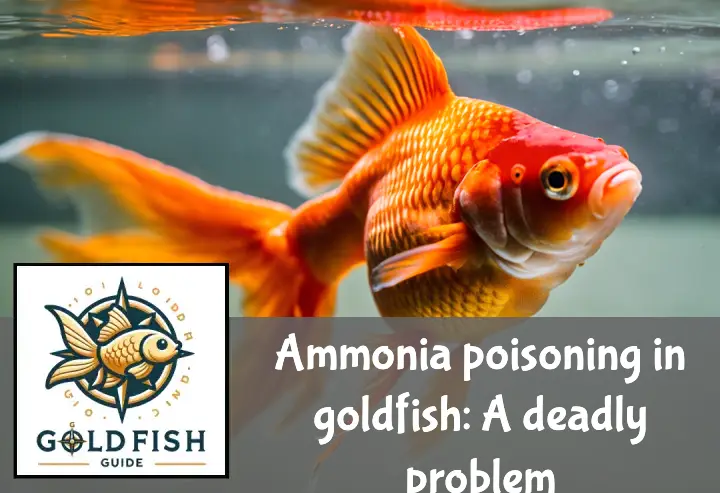Ever wondered why your goldfish is acting a bit wonky? Well, it might be more than just its quirky personality. It could be Ammonia poisoning in goldfish, a deadly problem that’s as serious as a heart attack – well, for your fishy friend at least.
Now, don’t go flushing your gilled pal down the toilet in panic! Stick around to find out how you can turn this potential catastrophe into a ‘swim in the park’. Keep reading about Ammonia poisoning in goldfish: A deadly problem!
Key Takeaways
- Ammonia poisoning in goldfish is a serious issue that can be fatal.
- It’s caused by poor water quality, often due to overfeeding or overcrowding.
- Symptoms include lethargy, loss of appetite, and red or inflamed gills.
- Immediate treatment involves changing the water and adding a water conditioner to neutralize ammonia.
- Long-term prevention includes regular water changes, not overfeeding, and maintaining an appropriate number of fish in the tank.
What is Ammonia Poisoning in Goldfish?
Ammonia poisoning in goldfish is a deadly issue that stems from poor aquarium water quality. It’s mainly caused by inadequate fish tank maintenance, leading to toxic ammonia levels. This situation can be detrimental to your goldfish’s health, causing severe discomfort and even death.
Understanding Ammonia
Ammonia is a natural byproduct of fish waste and decaying organic matter in an aquarium. It plays a significant role in the nitrogen cycle, which is vital for maintaining a healthy aquarium ecosystem.
However, when the balance gets skewed, ammonia levels can rise, posing a threat to your goldfish. The key here is the presence of beneficial bacteria that convert harmful ammonia into less toxic substances. But if these bacteria are not enough or absent altogether, then we’re looking at potential trouble.
How Ammonia Affects Goldfish
High levels of ammonia can cause noticeable changes in your goldfish’s behavior and health. Symptoms such as erratic swimming or gasping for air at the water surface may indicate an issue.
Long-term exposure to high ammonia levels can lead to chronic stress response and gill damage. And let me tell you folks – it ain’t pretty! So keep an eye on your fishy friends and ensure their home stays clean and safe!
Why is Ammonia Poisoning a Deadly Problem for Goldfish?
Ammonia poisoning in goldfish is no laughing matter. It’s a silent killer that can wipe out your finned friends faster than you can say “blub blub”.
The Impact of High Ammonia Levels on Goldfish Health
High ammonia levels in your fish tank can be like dropping an atomic bomb on your goldfish’s health. It doesn’t just cause immediate harm, but also long-term damage that can shorten their lifespan significantly.
The effects of high ammonia are brutal. It burns the gills and internal organs, causing severe discomfort and often leading to goldfish health deterioration. Imagine trying to breathe with your lungs on fire – not a pleasant thought, right?
Maintaining good aquarium water quality is crucial for preventing this disaster. If the toxic ammonia levels rise too high, it turns the fish tank environment into a death trap.
Symptoms of Ammonia Poisoning in Goldfish
Now, how do you know if your goldie has been hit by this invisible enemy? Well, there are several telltale signs of ammonia poisoning.
First off, look for changes in their behavior. A sick fish might become lethargic or start swimming erratically. These are clear goldfish behavior changes, indicating something’s fishy (pun intended).
Next up: physical symptoms. Your goldie might develop red streaks or inflamed gills – these are classic signs of ammonia burn. Also, keep an eye out for rapid breathing or loss of appetite – these could also signal trouble.
Remember folks, being vigilant about detecting fish illness early can save your goldie from becoming another victim of this deadly problem!
How Does Ammonia Build Up in Aquariums?
Ever wondered how your goldfish’s happy home can turn into a toxic trap? It’s all about the ammonia accumulation in aquariums. This silent killer builds up over time, making it crucial to understand the ammonia build-up process and keep those goldfish tank ammonia levels in check.
Sources of Ammonia in Aquariums
First off, let’s talk about where this sneaky substance comes from. One major culprit is fish waste. Yep, you heard right! Your goldfish’s poop is a prime source of ammonia. But don’t blame your finned friend entirely; they’re just doing their business!
Next up is uneaten food. Those extra flakes that sink to the bottom of the tank? They’re not just an eyesore; they contribute to the ammonia problem too. And let’s not forget about decaying plants – another biggie on the list of ammonia producers.
Lastly, there are bacteria involved in this whole mess too. Certain types play a role in producing ammonia, turning your aquarium into a potential danger zone for your goldfish.
Factors Contributing to Increased Ammonia Levels
Now that we’ve covered where ammonia comes from, let’s dive into what can cause its levels to spike. Overfeeding your fish is one such factor. More food means more waste and uneaten leftovers – both leading to higher ammonia levels.
Overstocking your tank also has a similar effect. Too many fish mean more waste and less space for beneficial bacteria that help control ammonia.
A poor filtration system can be another villain here, failing to remove waste efficiently and allowing ammonia levels to rise dangerously high. Finally, lack of regular water changes can contribute significantly to increased ammonia.
So remember folks, maintaining good aquarium water quality isn’t just about keeping things looking pretty; it’s a matter of life and death for your goldfish when dealing with ammonia poisoning in goldfish.
How Can You Detect and Measure the Level of Ammonia in Your Aquarium?
Keeping an eye on your aquarium’s ammonia level is like being a detective. It’s crucial to prevent ammonia poisoning in goldfish. Now, you might be wondering how to do this? Well, there are several tools for aquarium ammonia detection and measuring it accurately.
Tools for Measuring Aquarium’s Ammonia Level
One common tool is the ammonia testing kit, which comes with instructions so easy even a fish could follow them! Another handy gadget is the digital ammonia meter. This little device gives you a precise reading without needing any color charts or test tubes.
But wait, there’s more! The liquid test kit for aquariums is another popular option. It works by changing color based on the ammonia concentration in your tank. Lastly, we have the water quality monitor and the aquarium pH tester, both excellent tools for keeping tabs on your water conditions.
Interpreting the Results of an Ammonia Test
Understanding these tests isn’t rocket science, but it does require some knowledge. Safe levels of ammonia in fish tanks should always be 0 ppm (parts per million). If you see anything above that, it’s time to take action!
High levels of ammonia can cause symptoms in goldfish that are hard to miss. Look out for lethargy, loss of appetite, or rapid gill movement – these are all signs of high ammonia levels. So remember folks, when interpreting fish tank water tests, zero is your hero! Anything above that spells trouble for our finned friends.
How Can You Prevent and Treat Ammonia Poisoning in Goldfish?
Preventing and treating ammonia poisoning in goldfish is a crucial part of fish care. It involves preventive measures, immediate actions when high levels are detected, and long-term solutions.
Preventive Measures Against High Levels of Ammonia
To prevent high levels of ammonia, regular aquarium water changes are key. This helps keep the water fresh and reduces the buildup of waste products.
Another important aspect is your goldfish’s feeding habits. Overfeeding can lead to excess food decomposing in the tank, contributing to ammonia buildup. So remember folks, don’t let your love for your finned friends turn into an all-you-can-eat buffet!
Immediate Actions to Take When Detecting High Levels of Ammonia
If you detect high levels of ammonia, it’s time for some emergency aquarium care! The first step is to perform a large water change – this can quickly reduce the ammonia concentration.
Next up, consider using an ammonia-neutralizing product. These can be real lifesavers (or should we say fish-savers?) in protecting your goldfish health from those nasty ammonia spikes.
Long-Term Solutions for Managing and Reducing Aquarium’s Ammonia Level
For long-term management of your aquarium’s ammonia level, there are several strategies you can adopt. Using specific products designed to break down ammonia is one option.
Adjusting tank conditions can also help. For instance, maintaining a lower pH level can slow down the conversion rate of ammonium (less harmful) to ammonia (reducing aquarium ammonia levels). And remember folks – happy tank equals happy fish!
To Wrap Up
Just like a toddler who’s had too much candy, goldfish can get sick from their own waste—specifically ammonia. Ammonia poisoning in goldfish is no joke, folks!
So, keep your fishy friend’s home clean and check the water regularly. Remember, a happy goldfish is a healthy goldfish!



